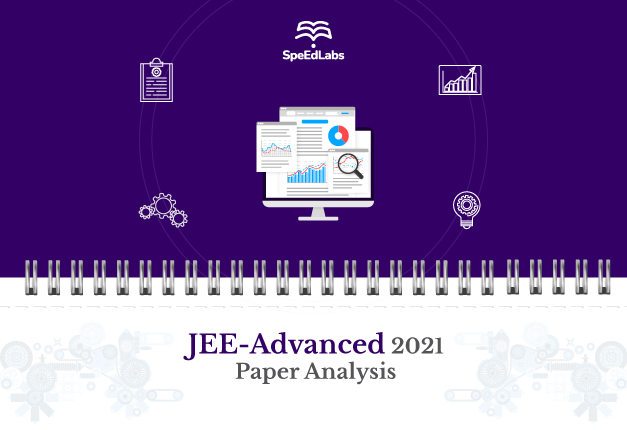The Joint Entrance Examination (JEE) Advanced 2021 for admission to the 23 IITs (Indian Institutes of Technology) was held on October 3, 2021 (Sunday) and was found to be in the range between moderate and difficult by a majority of students.
IIT Kharagpur conducted the exam under the pandemic’s full guidelines. The first paper of the JEE Advanced 2021 exam was held from 9:00 a.m. to 12:00 p.m., while the second session took place from 2:30 p.m. to 5:30 p.m.
JEE Advance paper analysis
The following blog covers the analysis of JEE advance 2021. This analysis is critical since it assists students in fully comprehending the paper layout, test overview, and difficulty level. Moreover, this JEE Advanced analysis will provide candidates with an insight into their test performance. They will also receive an indication of their chances of passing the exam. Let us understand the complete exam pattern precisely.
Numerical questions were asked in paragraphs for the first time in JEE Advanced. Each of the two papers had 54 questions. In Paper 1, each subject had six numerical questions, six single choice type questions, and six numerical value questions. On the other hand, Paper 2 included six integer-type questions, six multi-correct questions, and six numerical questions per subject.
JEE Advanced 2021 was easy than the previous year, according to exam participants. Physics is said to be the most difficult, with more problems drawn from the class 12 syllabus.
Let us understand the analysis of each subject individually:
Mathematics: Mathematics was difficult as compared to physics and chemistry. The language of the questions was quite confusing, with More weightage given on the class 11th portion.
Chapters covered: Functions, continuity and differentiability, application of derivatives, and definite integrals were among the topics covered. Most of the questions were from Calculus. Some excellent questions were present from the chapters on probability, complex numbers, and 3D geometry.
From Matrices and determinants, the base for linear mathematics, two questions were present. This section was easy for those who excelled in mathematics. Let us understand the pattern paper wise: –
- Paper 1: In Paper 1, the chapters on vectors, straight lines, complex numbers, probability, and matrices received attention from the paper setters. This paper’s math section was a “bit calculative.”
- Paper 2: More questions from Calculus and Coordinate Geometry were present in Paper 2. These questions were quite confusing and took a bit for students to understand, but all the questions were within the syllabus.
It was all about mathematics. This paper was not challenging for the students who excelled in this area and were well prepared to tackle twisted problems.
Physics: According to students, this portion was smooth than the other two subjects. The questions asked were within the syllabus.
Chapters Covered: The paper covered nearly every topic in the 11th and 12th-grade curriculum. Some complex problems were from current electricity, optics, rotation, and modern physics chapters.
Let us now cover the pattern paper wise:
- Paper 1: Paper 1 was calculative and a bit moderate level. Several important topics were in this paper, like electricity, rotation, modern physics, etc.
- Paper 2: A majority of students felt the physics section of paper 2 was simple to moderate.
- Mechanics: Six problems were from this topic. (Class 11th)
- Electrodynamics: Six Problems were from this chapter (Class 12th)
- Modern physics: Modern physics had three questions. (Class 12th)
- Heat, Thermodynamics, and Optics (Class 12th) constituted two problems each.
- Around seven questions were simple, nine intermediate, and the other three quite challenging.
Chemistry: The majority of the questions in the Chemistry paper were from the NCERT textbook. An equal number of questions were from the 11th and 12th school curricula. Physical Chemistry was more inclined towards numerical calculations.
Chapters covered: Questions in inorganic chemistry were taken directly from NCERT. Questions in physical chemistry encompassed titration, electrochemistry, and thermodynamics (kinetic theory gases). Questions about amines, biomolecules, and oxygen-containing compounds were from organic chemistry.
Let us now understand the pattern of chemistry paper wise:
- Paper 1: Organic Chemistry was the same as the year before, except for a few calculation-based difficulties. Inorganic chemistry gave increased weight to metallurgy, salt analysis, and coordination chemistry.
- Paper 2: In Physical Chemistry Paper 2, direct formula-based questions were asked. Some students struggled with paper two. This paper completely covered all the topics of the syllabus. This part was moderate to challenging, with around seven problems from physical chemistry, six from inorganic chemistry, and the remaining six from organic chemistry. There were about five questions students considered as easy. Also, twelve intermediate questions and two tough questions were present.
Key Takeaways
We can say that Mathematics was difficult, Physics was average, and Chemistry was easy. Although, this varies as no two students have the same potential and approach. Speaking about the complete exam, it was somewhat tricky, and in some places, confusing as well. But that does not mean it was not scoring. Chemistry was very scoring, and physics is no exception. Mathematics, on the other hand, could be done with a strategic approach.
Also published on Medium.
